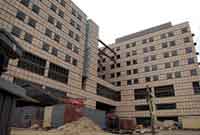 Trustee magazine has a more detailed story on the study done by Reed Construction Data/RSMeans Business Solutions. One finding of the study is that building trends have shifted since the boom started in 2000.
Trustee magazine has a more detailed story on the study done by Reed Construction Data/RSMeans Business Solutions. One finding of the study is that building trends have shifted since the boom started in 2000.
option for hospital upgrades, comprising an approximately $6 billion
market in 2005. But that doesnt mean organizations are thinking small.
The number of giant hospital construction projectsthose costing $100
million or morejumped from 67 in 2003 to 100 in 2005, according to
RSMeans.
The story goes on to explain the continued adoption of evidence-based designed as the reluctant acceptance of architectural wisdom by cost-obsessed hospitals. True, health care is not the most dynamic market, but we're not that bad!
Given today's relentless demographics, increasing health care IT adoption, combined with continued medical technology advancements, hospitals and designers are tying to build in flexibility.
that either are acuity-adaptablethey can be changed into ICU rooms
when the population gets older and sickeror instantly adaptable so a
patient can stay in the same room without a transfer to ICU, according
to Houston architect Mark Vaughan. Reducing the number of transfers has
been shown to decrease the risk of medical errors as well as eliminate
costs and staff time.
Universal beds or rooms are hospital rooms that can flex all the way to ICU rooms. Variable acuity rooms or acuity-adaptable rooms only flex up to an acuity on par with a high dependency unit. The build out costs between these two approaches are significant. I can certainly see hospital care evolving to where patient acuity is much higher than it is today, to include patients on continuous monitors and even ventilators. But will hospitals need to substantially increase ICU beds? I think not, especially if you consider today's inappropriate admissions that account for the majority of critical care overcrowding.
feature most commonly being installed for the purpose of flexibility is
wireless infrastructure, cited by three-quarters of respondents,
followed by extra cabling and conduit, power plant expansion capacity,
decentralized nurses stations and shell space for future expansion.
In addition to the above, expanded emergency communications systems are in the top 5 features being incorporated for mass casualty situations.
Be sure to check out the statistics at the end of the article.


Recent Comments